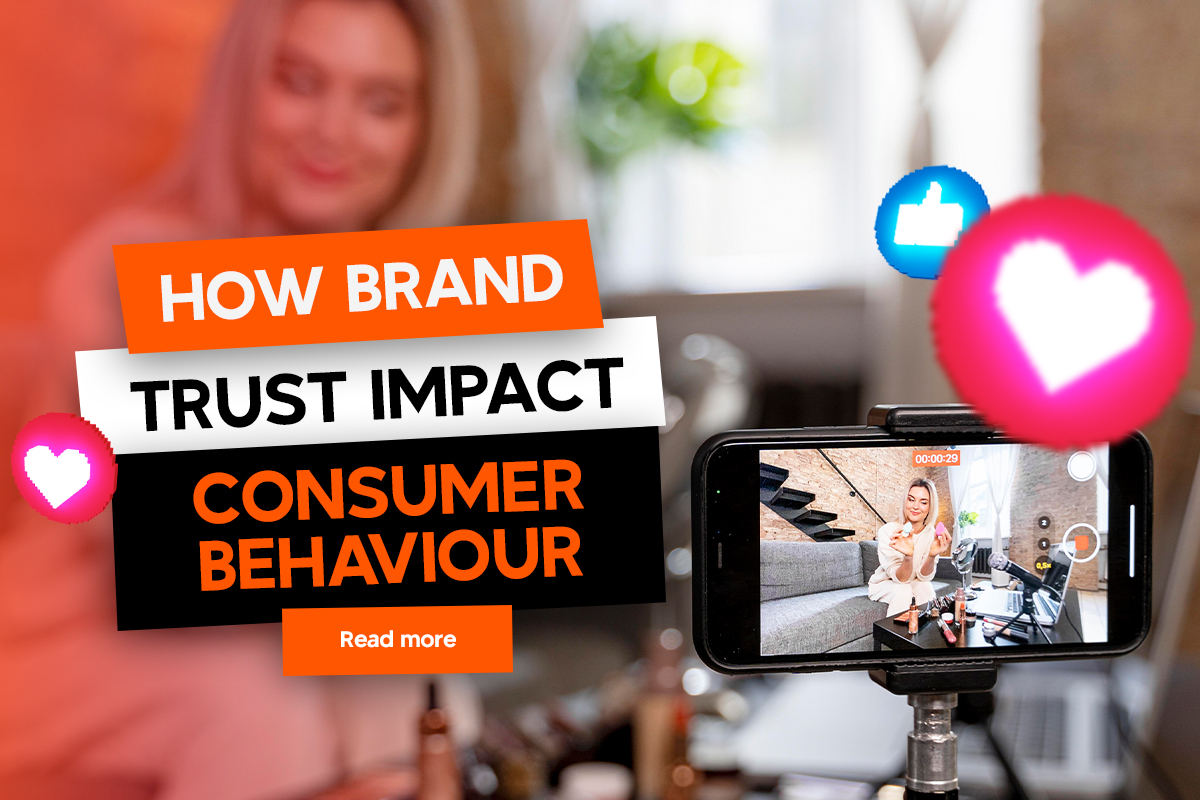
How Brand Trust Impacts Consumer Behavior
In today’s fast-paced world, trust is a vital ingredient in successful branding. When you think about the brands you love, trust likely plays a significant role in your loyalty.
But why does brand trust matter so much? It impacts your choices and influences your shopping habits. Whether you’re browsing online or shopping in-store, a brand’s reputation can sway your decisions.
In this blog, we’ll explore how brand trust shapes consumer behavior, how it can create lasting relationships, and why brands must prioritize building that trust.
Get ready to discover the powerful connection between branding and consumer loyalty!
The Psychology Behind Trustworthy Brands
When you think about the brands you trust, what comes to mind? Is it their catchy slogans, vibrant logos, or perhaps the warm feeling you get from their messaging?
It turns out that your feelings about a brand are deeply rooted in psychology. Understanding what makes a brand trustworthy can help you make better choices as a consumer.

Grow your Business with Creight: https://www.instagram.com/p/DA3I2iGvQup/
Let’s dive into the fascinating world of branding and discover the psychology behind it all!
Trust and Transparency
In today’s fast-paced world, trust has become the foundation of every strong relationship, including those with brands. When a brand is transparent, it shows you that it has nothing to hide.
You can easily spot trustworthy brands; they’re the ones that openly share information about their products, sourcing, and values.
You want to know where your food comes from or how your clothes are made. When brands provide that insight, it creates a sense of security.
Transparency fosters an environment of openness. Imagine you’re shopping for skincare products, and a brand highlights its commitment to cruelty-free testing and eco-friendly packaging.
You can feel good about supporting a company that aligns with your values. That’s the beauty of branding—it’s not just about selling products; it’s about building relationships based on mutual respect and shared values.
So, when brands embrace transparency, they invite you into their world, which can lead to increased loyalty.
Consistency is Key
Ever heard the saying, “A friend in need is a friend indeed”? The same principle applies to branding.
Consistency is crucial for brands to build trust over time. When you see a brand’s messaging, visuals, and values consistently presented, you start to develop a sense of familiarity.
Familiarity breeds comfort, and comfort leads to trust.
Let’s say you regularly buy your favorite coffee brand. They always use the same logo, colors, and tone in their advertising. Each time you see their familiar packaging, you know exactly what to expect.
This predictability builds a bond between you and the brand. You feel like you know them, which strengthens your connection. Trustworthy brands know that if they want to keep you engaged, they must stay consistent in their branding.
It’s all about creating that comforting, reliable presence in your life.
Emotional Connection Matters
Now, let’s talk about the heart of branding: emotions. You might not realize it, but your feelings play a significant role in your decisions.
When a brand taps into your emotions, it resonates with you on a deeper level. This connection can be a powerful driver of trust.
Think about it: when you encounter a brand that tells a heartwarming story or shares a cause you care about, it stirs something within you.
For instance, consider brands that support charitable causes or engage in community initiatives. When you see a brand actively contributing to social change, it makes you feel proud to support them. You want to be part of that positive movement.
This emotional connection can turn you from a casual consumer into a loyal advocate. You’ll find yourself sharing their messages with friends and family, spreading the word about how great they are.
That’s the magic of emotional branding; it creates a bond that transcends mere transactions.
Authenticity Over Perfection
In a world filled with perfectly polished advertising campaigns, authenticity shines like a beacon. You appreciate brands that embrace their imperfections and show their genuine selves.
When a brand acknowledges its flaws or shares behind-the-scenes stories, it creates a relatable persona. You can connect with them on a human level.
Think about a brand that shares its struggles or celebrates its achievements. You can see the real people behind the products, and that’s refreshing!
It reminds you that brands are not just faceless corporations; they are made up of individuals who care. This authenticity can significantly impact how you perceive a brand’s trustworthiness.
When you feel that a brand is real, you are more likely to engage with it and become a loyal customer.
Building Trust Takes Time
Building trust is not a sprint; it’s a marathon. Trustworthy brands understand that it takes time to establish a reliable reputation.
They consistently deliver on their promises, whether through product quality, customer service, or ethical practices. You expect brands to be there for you when you need them, just like a good friend.
Consider your favorite brands; they didn’t win your trust overnight. They worked hard to prove themselves.
Over time, they showed you that they cared about your experience and were committed to making it right. When a brand prioritizes your needs, you naturally gravitate toward them.
It’s a beautiful cycle; as you build trust in a brand, you become a loyal customer, and they continue to invest in your relationship.

Building Trust with Transparent Marketing Practices
In today’s fast-paced world, trust is like the currency of relationships, especially when it comes to branding. You want to feel confident in the choices you make.
Trustworthy brands foster this confidence through transparent marketing practices.
These practices not only make you feel good about your decisions but also create a connection that can last a lifetime.
Let’s explore how transparency can help you build trust with brands and why it’s essential for your shopping experience.
What Is Transparent Marketing?
Transparent marketing is all about honesty and openness. It’s the idea that brands should share clear information about their products and services without any hidden agendas.
Think of it like having a friend who always tells you the truth, even when it’s hard to hear. When brands practice transparent marketing, they give you insight into everything from sourcing materials to pricing strategies.
For instance, imagine you’re browsing for a new pair of sneakers. You come across a brand that not only shares the materials used but also explains the production process and how they ensure fair labor practices.
You can feel the genuine care that goes into their products. This transparency helps you make informed choices and feel confident in supporting a brand that aligns with your values.
You appreciate when brands don’t just market their products but also share the story behind them.
The Power of Honesty
Honesty is a fundamental pillar of branding. When brands are straightforward about their offerings, it creates an atmosphere of trust.
You want to know that when you spend your hard-earned money, you’re getting the real deal. Brands that prioritize honesty in their marketing efforts show you they value your trust more than flashy advertising.
Consider a situation where a brand makes a mistake, like a product recall. A trustworthy brand will communicate openly about the issue, provide details on how to handle it, and share steps they’re taking to fix the problem.
This level of honesty not only reassures you but also strengthens your connection with the brand. You know that they are willing to be accountable for their actions.
In a world filled with carefully curated marketing, honest brands stand out as refreshing and reliable.
Creating a Dialogue
Transparent marketing practices also encourage open communication between brands and consumers.
When brands actively engage with you, it fosters a sense of community. You feel like you’re part of something bigger, and that’s a fantastic feeling!
Brands can create platforms for dialogue, such as social media channels or blogs, where they share updates and listen to your feedback.
For example, imagine a skincare brand that invites you to share your thoughts on their new product. They ask for your opinions on ingredients, packaging, and effectiveness.
When brands seek your input, they show that they value your perspective. This two-way communication builds trust because it creates a sense of partnership.
You become more than just a customer; you become an integral part of the brand’s journey.
Sharing the Brand Story
Every brand has a story, and sharing it transparently can make a significant impact. You want to know the inspiration behind the products you love.
Transparent marketing means that brands will not shy away from sharing their challenges and successes.
When a brand opens up about its journey, it humanizes them and makes you feel more connected.
Think about a small business that started in a garage and grew into a thriving brand. When they share their story of hard work, perseverance, and community support, it resonates with you.
You can relate to their struggles and successes. This connection builds trust, as you see the real people behind the brand.
You’re not just buying a product; you’re investing in a story you believe in. That’s what branding is all about—creating emotional connections that last.
Accountability and Social Responsibility
In today’s world, consumers are more conscious of the brands they support. You want to back companies that share your values and are committed to social responsibility.
Transparent marketing practices align perfectly with this desire. When brands hold themselves accountable for their actions, it reflects their commitment to ethical practices.
Consider a clothing brand that emphasizes sustainable sourcing and fair labor practices. They transparently share information about their supply chain and environmental impact.
By doing so, they empower you to make informed choices that align with your values. You can shop with confidence, knowing that your purchase supports a brand that cares about people and the planet.
This sense of alignment fosters loyalty, as you feel good about your choices and the impact they have.
Building Long-Term Relationships
Ultimately, transparent marketing practices help build long-term relationships between brands and consumers.
When you trust a brand, you’re more likely to return for future purchases and recommend them to friends.
Trust fosters loyalty, and loyal customers are the backbone of any successful brand.
As you explore different brands, keep an eye out for those that prioritize transparency. Look for brands that share their values, communicate openly, and invite you into their journey.
When you find a brand that aligns with your beliefs and practices transparent marketing, it transforms your shopping experience.
You become a part of a community that values trust and authenticity.
How Social Proof Can Elevate Your Brand’s Credibility
When you think about the brands you trust, have you ever wondered why you feel drawn to them? The answer often lies in social proof. Social proof is the phenomenon where you look to others for guidance on what to believe or do.
It’s like having a friend recommend a new restaurant or a movie. When it comes to branding, social proof can significantly elevate your brand’s credibility.
Let’s explore how social proof works and how you can leverage it to build trust with your audience.
Understanding Social Proof
At its core, social proof is about validation. You want to feel confident in your choices, whether it’s a new product or a brand.
When you see others enjoying or endorsing something, it naturally boosts your confidence in that choice. Imagine you’re considering purchasing a new gadget.
You stumble upon glowing reviews and testimonials from people just like you. Instantly, you feel more inclined to make that purchase. That’s the power of social proof in action!
Social proof comes in various forms, including customer reviews, testimonials, influencer endorsements, and social media interactions. Each type serves as a signal that a brand is trustworthy and reliable.
When you encounter positive feedback from others, it creates a sense of community. You begin to see the brand as more than just a business; it becomes part of a larger conversation.
This connection can significantly impact your perception of the brand and your willingness to engage with it.
The Impact of Customer Reviews
One of the most potent forms of social proof is customer reviews. You might have noticed how you often check reviews before making a purchase.
Whether it’s an online store or a local restaurant, you want to know what others think. Customer reviews are a goldmine for building credibility.
They provide real-life experiences that help you make informed decisions.
When a brand actively encourages customer feedback, it shows that they value your opinion. You feel heard and appreciated as a customer.
Positive reviews can create a ripple effect, influencing others to try the product or service. Think of it this way: when you see a product with hundreds of positive reviews, it’s hard not to feel curious about it.
This curiosity can lead to increased sales and a stronger brand reputation.
Moreover, when potential customers see authentic reviews, they are more likely to trust the brand. You might be skeptical about marketing claims, but when real people share their experiences, it adds a layer of authenticity.
The more genuine and relatable the reviews are, the stronger the social proof becomes.
Influencer Endorsements
Another exciting aspect of social proof is influencer marketing. You might follow your favorite influencers on social media and trust their recommendations.
When influencers endorse a brand, it can significantly enhance that brand’s credibility. Their followers look to them for advice, and when they share positive experiences, it creates a powerful influence.
Think about the impact of an influencer using a skincare product and sharing their results. You may feel more inclined to purchase it because someone you trust has had a positive experience.
This relationship between brands and influencers creates a sense of authenticity. It makes the brand feel approachable and relatable, which is essential for successful branding.
However, it’s crucial for brands to choose influencers who genuinely align with their values. You want to make sure the influencer’s audience matches your target market.
When the endorsement feels authentic, it resonates with you, and that’s when social proof truly shines.
User-Generated Content
User-generated content (UGC) is another fantastic way to harness social proof. This is when your customers share their experiences with your brand on social media or other platforms.
When you encourage your customers to share photos or stories, it creates a sense of community around your brand.
You become part of their story, and that connection enhances your brand’s credibility.
For instance, imagine a clothing brand that encourages customers to post pictures wearing their products. When you see real people showcasing their style and confidence, it inspires you.
You can visualize yourself in those clothes, and that’s powerful! UGC acts as a visual testimonial, reinforcing the idea that others trust and love the brand.
Brands can take advantage of UGC by sharing it on their own social media channels or websites. This not only showcases happy customers but also fosters a sense of belonging.
When customers see their content featured, it makes them feel valued and appreciated. You’re more likely to engage with a brand that celebrates its community.
Building Trust Through Social Proof
At the end of the day, social proof is all about trust. You want to feel confident in your decisions, especially when it comes to spending your money.
When brands leverage social proof effectively, they create an environment of trust and credibility. You can make informed choices based on the experiences of others.
As you navigate the world of branding, remember the importance of social proof. Encourage your customers to share their experiences, whether through reviews, testimonials, or social media.
Collaborate with influencers who align with your values, and showcase their endorsements authentically. Create a sense of community around your brand by highlighting user-generated content.
Strategies for Managing Brand Crises and Rebuilding Trust
Every brand hopes for smooth sailing, but sometimes, stormy weather hits. A brand crisis can feel overwhelming and daunting, but the good news is that it can also be an opportunity to rebuild trust.
You might find yourself wondering how to navigate these rough waters and come out stronger on the other side. Let’s explore some effective strategies for managing brand crises and restoring trust with your audience.
After all, a resilient brand can thrive even in challenging times!
Acknowledge the Issue
When a crisis strikes, the first step is to acknowledge the issue openly. You don’t want to bury your head in the sand, hoping it will go away. Instead, face the situation head-on.
Transparency is key. You want your customers to know you are aware of the problem and are taking it seriously.
For example, let’s say a product recall is necessary due to safety concerns. You should communicate the issue as soon as possible, explaining what went wrong and what you are doing to resolve it.
This approach shows your audience that you are committed to their safety and well-being. They will appreciate your honesty and are more likely to trust you moving forward.
Remember, you want your customers to feel valued and informed during a crisis.
Communicate Proactively
Once you’ve acknowledged the issue, it’s time to communicate proactively. You want to keep your audience in the loop, so they feel involved in the process.
Use various channels like social media, email newsletters, and your website to share updates.
This consistent communication helps you maintain transparency, which is crucial for rebuilding trust.
Imagine you are a customer affected by a crisis, and you see your favorite brand regularly updating you on the situation.
You feel reassured knowing that the brand cares about your concerns. Proactive communication also prevents misinformation from spreading.
When you’re open and honest, you reduce the chances of rumors or negative speculation taking hold. It’s all about keeping the lines of communication open and fostering a sense of community.
### Take Responsibility
Taking responsibility is essential during a brand crisis. You must own up to any mistakes and accept accountability. You might feel tempted to shift blame or minimize the situation, but that’s not the way to rebuild trust.
Customers want to see brands act with integrity, especially when things go wrong.
For instance, if a service you provide has been unreliable, admit it! A simple apology can go a long way in regaining trust.
Acknowledge the impact your actions have had on your customers, and express your commitment to making things right. This willingness to take responsibility shows that you genuinely care about your audience and their experience with your brand.
You’re not just a faceless corporation; you’re a brand that values relationships and accountability.
Show Empathy
During a crisis, empathy is your secret weapon. You want to connect with your audience on a personal level. Show them that you understand their feelings and frustrations.
When customers see that you genuinely care, it strengthens their trust in your brand.
For example, if your brand is involved in a controversy, consider sharing stories or testimonials from customers affected by the situation.
Acknowledge their feelings and let them know you are there to support them.
This empathetic approach can humanize your brand and create a sense of belonging. You’re not just addressing the issue; you’re also addressing the emotional impact it has on your audience
Implement Changes
Once you’ve acknowledged the issue, communicated openly, and taken responsibility, it’s time to implement changes. Show your audience that you’re not just paying lip service but are committed to making improvements.
Outline specific actions you will take to prevent similar crises in the future.
For instance, if your brand faced quality control issues, you might invest in better testing processes or training for your team. Share these improvements with your customers to reinforce their trust.
When they see you making tangible changes, it signals that you’re dedicated to providing a better experience.
It’s all about turning a negative situation into a positive learning opportunity for your brand.
Engage with Your Audience
Engaging with your audience during a crisis is essential. You want to create a sense of community and show that you value their opinions.
Consider hosting Q&A sessions or open forums where customers can voice their concerns and ask questions.
This interactive approach can help demystify the situation and show your audience that you care about their feedback.
Think about how comforting it is to connect with a brand that values your input. You feel like part of the solution, and that can strengthen your bond with the brand.
Engaging with your audience fosters trust and loyalty, allowing them to feel more connected to your brand.
Focus on the Positive
While it’s essential to address the crisis, don’t forget to focus on the positive aspects of your brand. Highlight your successes, customer stories, and community involvement.
This strategy can help shift the narrative and remind your audience why they loved your brand in the first place.
For example, if your brand is involved in charitable initiatives, share those stories! Highlight how your brand positively impacts the community.
You can create a sense of hope and optimism, even during challenging times. This approach helps your audience remember the values that drew them to your brand, reinforcing their trust.
Building a Stronger Brand
In conclusion, managing brand crises requires a proactive and empathetic approach. By acknowledging the issue, communicating openly, taking responsibility, and implementing changes, you can rebuild trust with your audience.
Engage with your customers and focus on the positive aspects of your brand.
Remember that crises are not the end; they can be opportunities for growth and learning. When handled effectively, your brand can emerge stronger and more resilient.
So, embrace the challenges, and show your audience that you are committed to building lasting relationships.
Your efforts will not go unnoticed, and in the end, you’ll cultivate a loyal community that stands by your side through thick and thin!


